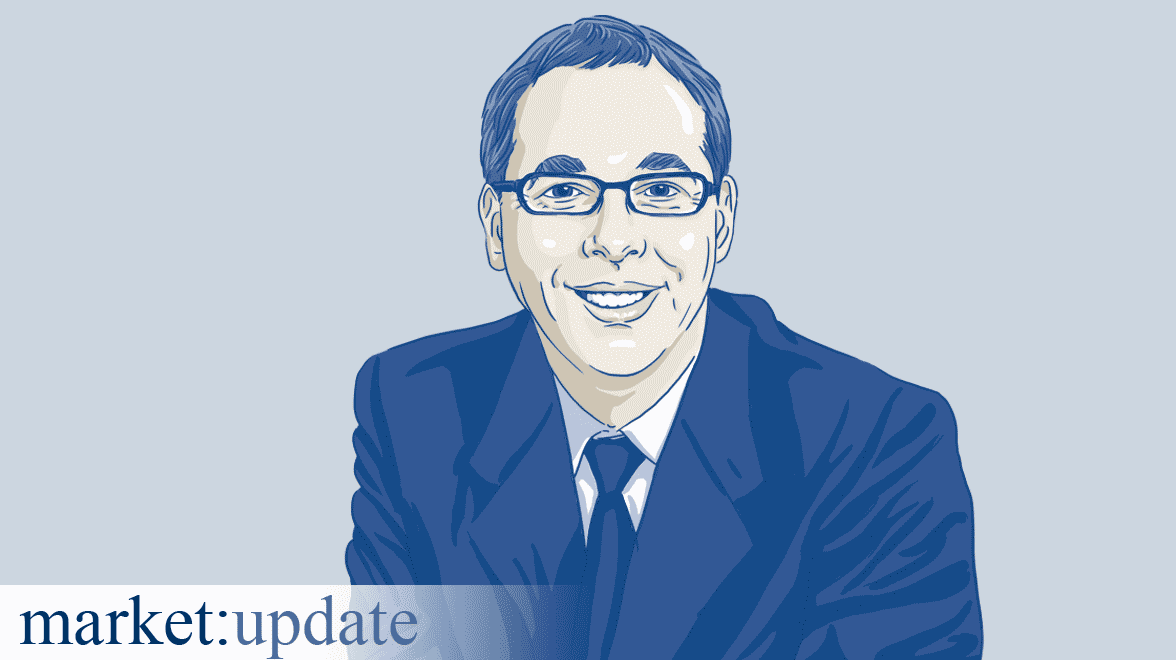Q1 outlook: Inflation declines faster than expected, restrictive monetary policy slows global economic growth
Bond markets: interest rates are back and bonds promise good long-term returns
The fourth quarter saw an interesting divergence in the European bond market. Government bonds suffered losses while corporate bonds posted moderate gains. This ended one of the worst years for bond investors. According to ICE BofA's bond indices, losses totaled 17.6 percent for Bunds and as much as 18.2 percent for euro zone government bonds. European corporate bonds lost slightly less, but still ended the year down 13.9 percent. European high-yield bonds also recorded a significant loss of 11.5 percent due to the fierce reaction of central banks to high inflation. There hasn’t been a comparable cycle of interest rate hikes in the USA and Europe since the 1970s.
Interest is back! According to our estimates, yields on government and corporate bonds have now reached levels that promise good returns in the long term and definitely offer a real alternative to equities — especially when volatility is taken into account. Investment grade corporate bonds from the euro zone offer the best ratio of expected return to historical volatility. Central bank rate hikes and the foreseeable economic downturn are likely to contribute to a marked increase in credit defaults. However, European investment grade companies have taken advantage of the low interest rate phase to issue long-dated corporate bonds; they thus have only a small refinancing need at the currently high interest rates this year and next. High-yield companies, on the other hand, have often also taken on short-term debt, which could contribute to increased loan defaults in this segment this year and especially next year. Basically, we see an environment with high economic risks where the financial markets may have already priced in too many key interest rate hikes. If financial market players price in fewer rate hikes this year, there is a chance that government bond yields will fall moderately again. The outlook for the European bond markets in 2023 is therefore quite positive.
Equity markets: difficult liquidity environment, but positive impulses could prevail in the first quarter of 2023
The fourth quarter brought the long-awaited countermovement on the international equity markets. The MSCI Europe gained about 10.5 percent and closed the year about 8.0 percent in the red. The MSCI World performed worse, gaining about 7.6 percent in the fourth quarter and losing 15.6 percent for the year. The MSCI Emerging Markets Index gained about 6.7 percent in the fourth quarter, but also suffered a significant loss of 15.2 percent in 2022 — both in local currency. The substantial price gains in the fourth quarter are somewhat surprising at first glance, as central banks tightened liquidity noticeably with the help of substantial interest rate hikes and balance sheet reductions. However, the noticeable decline in energy prices, the opening of the Chinese economy and resilient economic data from Europe were able to counteract this with sufficient positive impulses.
Central banks will stick to their plans to raise key interest rates and reduce their balance sheets in the first quarter. The liquidity environment is thus likely to remain difficult and exert downward pressure on the equity markets. However, this will be countered by the factors that already provided a boost in the fourth quarter: falling energy prices, a consumption boom in China and resilient economic data from Europe. Overall, the positive impulses could still prevail in the first quarter. However, the inverted yield curves in the USA and Europe are a warning. They signal a restrictive monetary policy that is already slowing demand growth in Europe and the USA. At the same time, labor markets in Europe and the USA remain incredibly strong and wage dynamics are high. Against this backdrop, there could be increasing pressure on corporate profit margins and thus earnings disappointments. The outlook for the equity markets is not clearly negative or positive. It therefore looks like volatile sideways movement is likely.
Euro zone economy: narrowly escaped recession, but no dynamic upswing in sight
Surprisingly, despite the energy crisis, Europe was spared a recession in the fourth quarter. Thus, the first estimate of the German statistics authority shows that the German economy stagnated in the fourth quarter. Of all European countries, Germany has certainly been hit the hardest by the energy crisis so far. It is therefore likely that the other European countries also stagnated, some even achieving moderately positive growth. The warm winter, considerable savings in gas consumption in industry and private households as well as an improved supply of liquefied petroleum gas ensured that natural gas prices fell noticeably during the quarter. This was accompanied by a drop in electricity prices. We therefore adjusted our growth forecasts for the euro zone and now expect growth of 0.0 percent in 2023 and 1.0 percent in 2024.
A more resilient euro zone economy means that there are fewer disinflationary pressures and inflation could thus decline more gradually. It also means that the European Central Bank (ECB) has more scope to raise key interest rates. Especially since European government bond markets have been extremely stable in recent weeks and have not priced in any higher risks of a return of the sovereign debt crisis due to ECB rate hikes. Obviously, good economic developments in countries with a low credit rating and the ECB's TPI (Transmission Protection Instrument) sufficiently calmed the nerves of financial market participants.
We expect two rate hikes in February and March of 2023 of 0.5 percentage points each to 3.0 percent. Financial market players, on the other hand, are pricing in key ECB rate hikes of up to 3.5 percent Unlike market participants, we expect inflation to decline faster and see greater economic risks towards the middle of the year. Inverse yield curves in the USA and Europe have always been a reliable signal of an economic slowdown in the past. The central banks' interest rate hikes, which have a significant influence on the yield curve and can already be classified as restrictive, will thus noticeably slow down global economic growth. This means that a dynamic upswing is not to be expected — even if Europe manages to avoid a recession this winter. Accordingly, we also see a high probability of key interest rate cuts in the fourth quarter of 2023.
US economy: slightly negative economic growth and a significant decline in inflation
Signs of a noticeable slowdown in the US economy increased in the fourth quarter. For example, companies in both the industrial and service sectors reported a significant decline in new orders in December, according to a survey by the Institute of Supply Managements (ISM). The housing market also showed significant weakness; it is usually the first market to go into a downturn but also the first to go back into recovery.
Only the labor market remained a haven of stability. In December, the unemployment rate even fell again to 3.5 percent. Experience shows, however, that the labor market is always the last to react in a cycle, so that here, too, weakening tendencies are to be expected in the coming months. There is some uncertainty as to whether the typical cyclical patterns will also apply to the labor market in this downturn. There is already a discernible labor shortage, which could increase in the coming years due to the "baby boomers" retiring. In this environment, companies will be reluctant to release workers, as they could be sorely lacking in the next upswing. Thus, companies may be more willing to accept some reduction in their profit margins before they begin to reduce their workforces. The marked decline in US inflation in recent months shows that companies no longer seem to be able to compensate for rising labor costs by raising prices as they did in 2022. Thus, the signs are pointing to a downturn but not to a recession due to the stable labor market.
We expect US economic growth to be moderately negative at -0.5 percent and therefore also expect inflation to decline significantly to 3.5 percent. Actually, the US Federal Reserve is already too restrictive, as signaled by the inverted yield curve. Nevertheless, we still foresee an interest rate step of 0.25 percentage points in February and then expect a pause in interest rate steps for the time being. In the fourth quarter of 2023, we foresee good opportunities for interest rate cuts.
Asian economy: turbulence on the financial markets in Japan; a noticeable growth revival in China
Japan suffered a painful "terms of trade" shock in 2022: import prices rose significantly faster than export prices, resulting in a significant loss of prosperity. As a result, economic growth weakened from 2.3 percent in 2021 to probably 1.3 percent in 2022. At the same time, higher import prices also seem to have triggered some inflation momentum in Japan. In December, core inflation (excluding energy and food prices) in the Tokyo metropolitan area rose to 2.7 percent — significantly above the central bank's inflation target of 2.0 percent.
Sluggish wage dynamics with growth rates of only about 1.3 percent could not keep up with inflation rates, so that Japanese households had to accept a noticeable loss of real wages. The low wage dynamics also showed that domestic inflationary pressure is still rather low. Nevertheless, the Japanese central bank surprised financial market players in December by widening the trading band for the yield on 10-year government bonds to a corridor of -0.5 to +0.5 percent. As a result, there was repeated turbulence on the bond market. Accordingly, the Bank of Japan had to buy Japanese 10-year government bonds to a considerable extent in order to prevent the yield on 10-year government bonds from rising above 0.5 percent.
The turbulence on the financial markets signals that the Bank of Japan will soon have to act again. Currently, financial market players are pricing in a raise in the key interest rate from -0.1 percent to 0.25 percent in the course of 2023. The trading band for the 10-year government bond yield could also be widened again. Due to expectations of a monetary policy reaction by the Japanese central bank, the Japanese yen recently gained noticeably on the foreign exchange markets.
The Chinese government surprised in the fourth quarter with the decision to end all corona measures. The opening of the Chinese economy — also towards foreign countries — seems to have triggered a consumption and travel boom in China after a long period of lockdown. We have therefore raised our growth forecast from 2.0 to 3.0 percent for 2023. However, we expect a noticeable acceleration of growth only in the first half of the year, as the accumulated surplus savings can only be spent once.
We still see major structural problems in the Chinese economy. For example, the Chinese government is doing a lot to support the construction industry in order to prevent a crash in the real estate market, but it has hardly any means to stimulate demand. The demographic trend reversal, the high ownership rate, and the expectation of stagnating prices are likely to at least dampen the will to buy. Moreover, the growth model also seems to have reached its limits. In 2022, for example, it would take an increase in debt of 10.2 percent to achieve nominal economic growth of probably around 4.5 percent. The result is a noticeable increase in debt.
More articles
This document published by Metzler Asset Management GmbH [together with its affiliated companies as defined in section 15 et seq. of the German Public Limited Companies Act (Aktiengesetz – "AktG”), jointly referred to hereinafter as “Metzler“] contains information obtained from public sources which Metzler deems to be reliable. However, Metzler cannot guarantee the accuracy or completeness of such information. Metzler reserves the right to make changes to the opinions, projections, estimates and forecasts given in this document without notice and shall have no obligation to update this document or inform the recipient in any other way if any of the statements contained herein should be altered or prove incorrect, incomplete or misleading.
Neither this document nor any part thereof may be copied, reproduced or distributed without Metzler‘s prior written consent. By accepting this document, the recipient declares his/her agreement with the above conditions.
 Deutsch
Deutsch English
English


